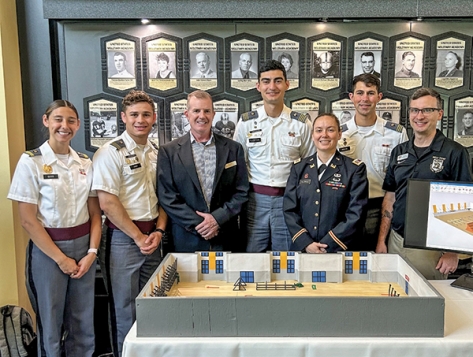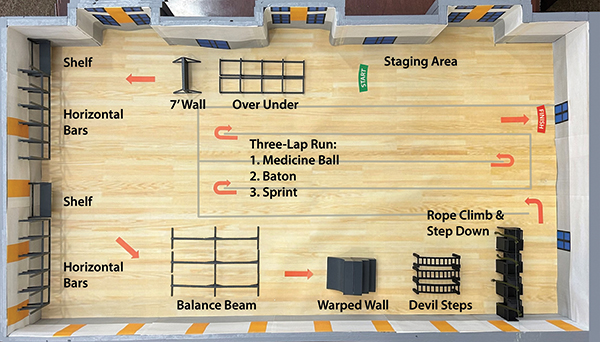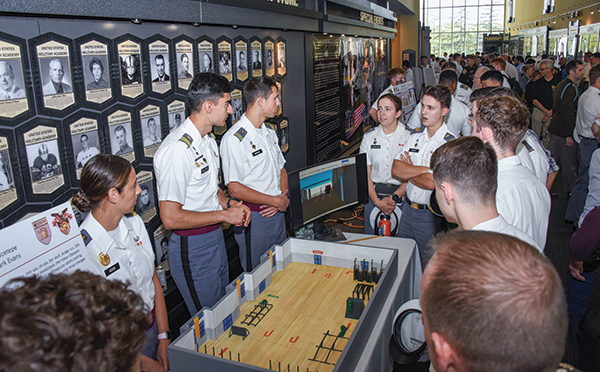By CPT Jennifer Alonso ’14 and Dr. John Borman, DPE, Guest Authors
Due to potential future renovations of Hayes Gymnasium, the Arvin Cadet Physical Development Center is seeking an alternative space to house the Indoor Obstacle Course Test (IOCT) for several years. The test became a stand-alone graduation requirement beginning with the Class of 1977. Yet, West Point cadets have been tackling the IOCT for decades, going back to 1939, when Dr. Lloyd Appleton, an instructor in the Department of Physical Education (DPE), created the 10-event “Military Physical Efficiency Test.”
“The IOCT is the ultimate physical and mental challenge at West Point,” said now-Second Lieutenant Kevin Yucetepe ’24, one of four Civil Engineering majors who worked on redesigning the IOCT for the second-floor gym of Arvin and presented their proposal during the 2024 Projects Day Research Symposium at West Point.

While redesigning the IOCT for DPE, the cadets encountered many obstacles: space limitations, elevation requirements, safety considerations, and, most notably, meeting the needs of multiple interested parties with distinct perspectives and varying opinions. To overcome these obstacles, the IOCT Capstone Team implemented the engineering design process.
They methodically evaluated the current IOCT, created new obstacles, and presented courses of action for obstacle layouts in the second-floor gym that will test cadet’s agility, balance, coordination, stability, flexibility, posture, speed, and power—capabilities, and movement skills described in Army Field Manual 7-22.
“One of the biggest challenges we faced was maintaining the historical integrity of the IOCT while designing a new course that contains some improved, military-relevant, and challenging obstacles for a one-story open space,” said now-Second Lieutenant Alex Goss ’24. The team researched and analyzed obstacle courses from around the world, focusing on military courses and the television show American Ninja Warrior.

The final design of the adjusted IOCT starts with a new over-under obstacle that requires cadets to slide under a beam and then vault over a beam several times. Once complete, they must immediately scale a 7-foot wall. Then, they must mount a shelf and traverse horizontal bars (both of which remain unchanged from the current IOCT). Upon dismounting the horizontal bars, they must navigate a balance beam and complete a forward roll upon landing. Then, they must scale a new obstacle, a 12-foot warped wall with a series of three-foot drops to the floor. From there, they must quickly traverse the devil steps, an additional new obstacle defined as a horizontal ladder with a series of five ascending bars, two parallel bars, and five descending bars. They then climb a 15-foot rope and navigate another series of 3-foot staggered drops to the base level. The test concludes with a three-lap shuttle run, carrying a medicine ball during the first lap, a baton during the second lap, and no load on the final lap. In this new design, the IOCT Capstone Team attempted to achieve the same fitness objectives of the current test in a footprint that is two-thirds of the existing space and with elevation limitations.
“These outstanding future leaders applied their collective passion for engineering design and physical fitness to innovate solutions while sustaining traditions for the future of the IOCT,” said Colonel Nicholas Gist ’94, Master of the Sword (Director of the Department of Physical Education).
“The process and product are results of their boundless mental agility and tremendous teamwork.” In other words, although the Indoor Obstacle Course Test may change in form and location, it will not change in its true function: challenging the Corps of Cadets physically and mentally with the ultimate intent of developing leaders prepared for commissioning.
Read the complete Summer 2024 edition of West Point magazine here.
What do you think? Click here to answer four questions.




